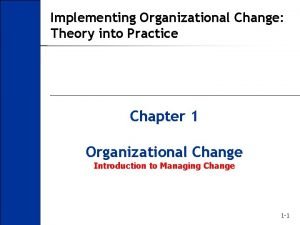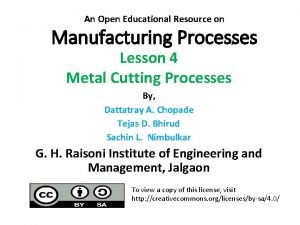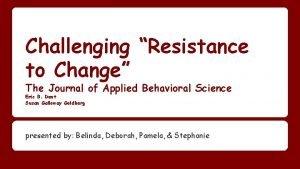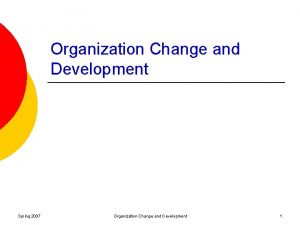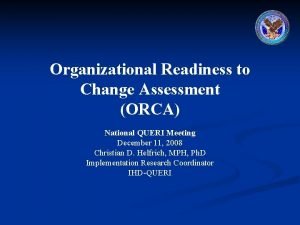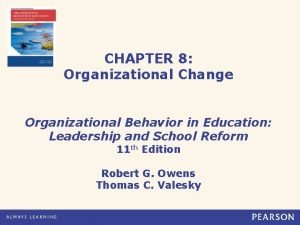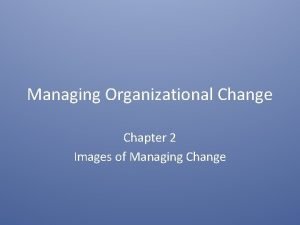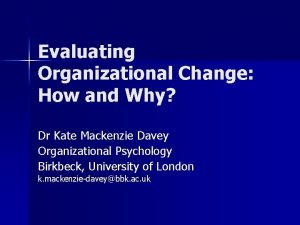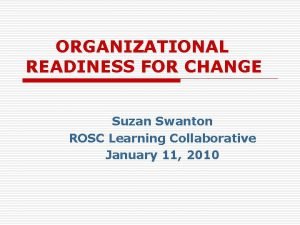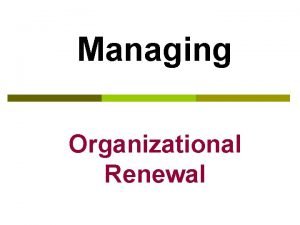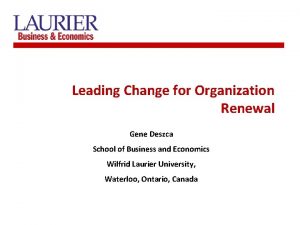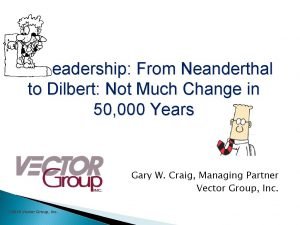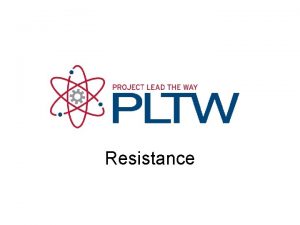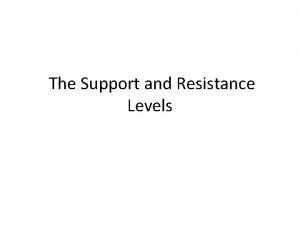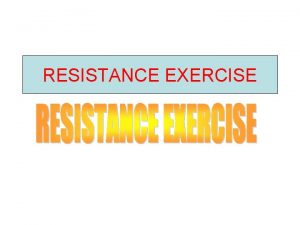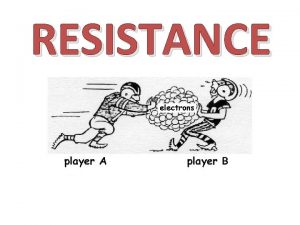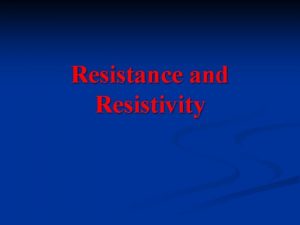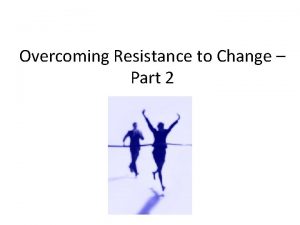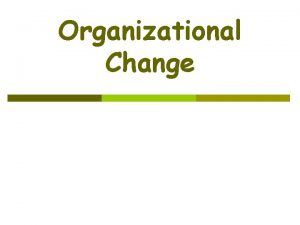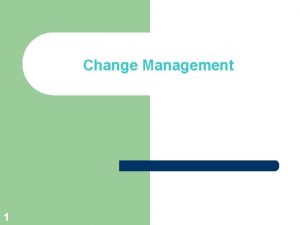Transform Resistance into Support During Organizational Change Organizational

































- Slides: 33

Transform Resistance into Support During Organizational Change

Organizational Change • 70% organizational change efforts fail • Change is constant in a dynamic environment • The only certainty is continuing uncertainty • Need change to stay competitive & profitable Prentice Hall, 2002

My Communication Connection • • Ph. D in Organizational Communication Corporate Trainer TV News Anchor Professor

Types of Organizational Change • Normal business cycles • Crisis • Planned: current ways ineffective

Vision & Communication • Create vision – Purpose – What will be accomplished – How it will benefit everyone – Needs to be relevant & realistic • Communicate vision

Vision & Communication • How change is communicated is important because…. . – Will only succeed if everyone is committed, not just upper management – Needs buy-in from all levels – Managers need to effectively communicate vision & need support in doing that • Build communication systems into everything to continually communicate the vision

Planning & Preparation • Analyze, assess, & anticipate: – Benefits vs. costs – Impact on existing processes & systems – Potential problems with systems & people – Impact on employees • especially those most affected • Develop step-by-step plan for integration

Communication in Planning Stage • Anticipate communication issues • Prepare for full range of reactions • Plan for arguments from those who “lose” – Be proactive – Ready to respond

Motivate Employees • Overcomes resistance • Need sense of urgency or will cling to status quo & resist change • Gain support – Powerful group of leaders need to be on board – Passive resistance from a few can sabotage efforts

Implementation & Momentum • Implement – Test run in unit that is prepared – Follow step-by-step plan for implementation & integration – Ongoing correction, training, coaching, soliciting input • Sustain momentum – Ongoing support from leadership – Reward & recognition programs

Communicating Change • Communication needs to be: – Face-to-face – Comprehensive • Communicate criteria for successful change outcomes – Make adjustments • No response is never a good response – Leads to rumors – “I don’t know” is better

Reactions During Change • Ownership • Uncertainty • Resistance

Why People Resist Change Prentice Hall, 2002

Resistance • • • Fight or flight Uncertainty triggers defensiveness & resentment When in doubt, we don’t act Mistrust Overwhelm, lower productivity

Sources of Resistance • • • Perceptions of personal threat Cost outweighs benefit Mismanagement Previous experience with failure Complacency

Sources of Resistance • Organizational conditions (toxic, competition, etc. ) • Decisions handed down • Lack of communication

Employee Concerns • Employees less concerned about financials, targets, etc. • Want to know impact on them & their jobs – Will they still have one? – Will it be substantially changed? – Easier or more difficult – WIIFM

Employee Concerns – Wishing a different part or level of the organization would change – Finger pointing, blaming – Impact of power shifts across groups & management What can we do?

Importance of Listening • Employees don’t feel heard • Listen to employees – To their fears, concerns – They need to feel heard – Need to feel valued – Need to feel some sense of control due to the loss or fear of loss

Gain Support by Listening • Gain employee support during implementation – Involve them – Include in decision-making process early on – Encourage participation from employees at all levels – Listen to their feedback, input, recommendations – Use their input – Ongoing involvement • Check for Understanding

Effective Communication • Manage successful organizational change – Consider (determine) how, when, & who change is communicated to – Consider timing and channel – Match message to medium (not email)

Effective Communication • Explain why • Clearly explain impact on their jobs • Fill in the blanks or they will make stuff up & start rumors • Alleviate fear & reduce uncertainty through clear communication

Communicating Benefits • Discuss openly & honestly – How it will improve things – Make jobs easier – Benefit everyone – If not, be honest • Benefits of selling benefits – Increase enthusiasm – Overcome resistance

Smooth Transition • Open communication across hierarchical levels • Build shared purpose • If possible consider incremental change – Refine & adjust in process – Easier acceptance

Why Change Fails • • Lack of management support Top managers forcing change Inconsistent actions by managers Unrealistic expectations – Develop realistic approaches – Realistic timeline expectations

Why Change Fails • • Lack of participation Purpose unclear Responsibility for change not identified Poor communication

Communication Mistakes • Not enough communication, a few meetings & memos • Leader gives lots of speeches & communicates, but managers are silent • Withholds information • Information passed down through hierarchical levels • One big company announcement at one big company meeting • Behavior doesn’t match the vision or what is said

Avoid Communication Mistakes • Give clear explanations • Need continual & direct communication • Don’t use 1 -way communication: memos, emails, etc. be present to answer questions • Inadequate training (especially in communication): ask questions

Organizational Culture • Bring organizational culture into alignment with change – Transform how organization and employees view change – Ensure management supports change – Use best leadership practices – Change needs to be incorporated into culture – Succession decisions are key to maintaining change

Organizational Alignment • Leaders model behavior expected of employees • Reward people for alignment with vision • Need: respected leaders, motivated people, collaboration

Contact Information Patty Malone, Ph. D 949. 200. 9064 info@drpattymalone. com www. drpattymalone. com • Training • Speaking • Communication Audits • Assessments “Communicate Better. Get Results. ”

Training & Speaking • • • Organizational Change Conflict & Difficult people Building Teams Clear Business Presentations Clear Communication across teams, departments, all levels, generations

Transform Resistance into Support During Organizational Change
 Implementing organizational change theory into practice
Implementing organizational change theory into practice Filter medium resistance formula
Filter medium resistance formula What is a force that opposes motion through direct contact
What is a force that opposes motion through direct contact Metal resistance to shear during chip formation is known as
Metal resistance to shear during chip formation is known as Resistance to change images
Resistance to change images Resistance to change in an organization
Resistance to change in an organization Challenging resistance to change
Challenging resistance to change Internal forces of change in an organization
Internal forces of change in an organization Resistance to change
Resistance to change The unit that transforms data into information is the
The unit that transforms data into information is the Transform the positive sentences below into negative form
Transform the positive sentences below into negative form Direct indirect questions
Direct indirect questions Major points examples
Major points examples What change took place in hinduism during the gupta empire?
What change took place in hinduism during the gupta empire? Organizational change adalah
Organizational change adalah Development change adalah
Development change adalah Organizational theory design and change
Organizational theory design and change Organizational readiness to change assessment (orca)
Organizational readiness to change assessment (orca) Organizational change in education
Organizational change in education Organizational change and stress management
Organizational change and stress management Navigator image of managing change
Navigator image of managing change Bert spector
Bert spector Evaluating organizational transformation
Evaluating organizational transformation Organizational readiness for change maryland
Organizational readiness for change maryland Leading change and organizational renewal
Leading change and organizational renewal Leading change and organizational renewal
Leading change and organizational renewal Dilbert organizational change
Dilbert organizational change What is an organization
What is an organization Parabola vertex form
Parabola vertex form How can one type of rock change into another type of rock?
How can one type of rock change into another type of rock? How to change an equation into slope intercept form
How to change an equation into slope intercept form Parts of vertex form
Parts of vertex form We are taught grammar by ms sullivan
We are taught grammar by ms sullivan Adverbs soft
Adverbs soft
